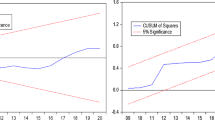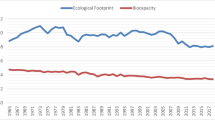Abstract
This study focuses on the channel for improving environmental quality in Brazil, Russia, India, China and South Africa (BRICS). Hence, we interact non-renewable electricity consumption with capital investment to determine the mediating role of capital investment in the nexus between electricity consumption and carbon emission in BRICS. This study applies the fully modified and the dynamic ordinary least squares techniques to conduct this scientific enquiry, and the result suggests that electricity consumption and growth positively and significantly enhance the level of emissions, while capital investment significantly reduces the level of emissions in BRICS. Also, capital investment interacts with non-renewable electricity consumption to improve environmental quality in both approaches employed, thereby reversing the earlier increase in emissions caused by electricity consumption. In addition, we confirm the proposition of the environmental Kuznets curve in BRICS and conclude that capital investment is an important channel for improving environmental quality.

Source: Authors’ Computation (2017)

Source: Authors’ Computation from WDI (2017)

Source: Authors’ computation from WDI (2017)
Similar content being viewed by others
Notes
The Pollution haven hypothesis opines that to set up international subsidiaries, firms always search for countries where they can easily operate at the lowest possible costs either in terms of obtaining cheap resources or in terms of circumventing the payment of carbon tax.
Lax environmental laws: This is a situation whereby a country’s environmental policies are either poorly implemented or do not exist at all. This can make such country become a haven for environmental pollution.
Porter hypothesis was articulated by Michael Porter in 1995, and it suggests that a tight environmental regulation can help to stimulate innovative consciousness in a country and induce efficiency needed for generating commercial competitiveness.
Pollution halo theory reveals that carbon emissions can be reduced through the transfer of advanced technology triggered by foreign direct investment to host countries.
The Paris Agreement is built on the United Nations Framework Convention on Climate Change (known as “the Convention”. The Convention encourages every nation to participate in the common goal of battling climate change and keep world temperature below 2 °C and further strive to lower future temperature increases well below 1.5 °C.
Copenhagen Accord provided a document drafted by the USA and agreed on by other 140 countries. In the Accord, emissions reduction targets for 2020 were set and mitigation actions were also arrived at for developing countries.
References
Akpan, G. E., & Akpan, U. F. (2012). Electricity consumption, carbon emissions and economic growth in Nigeria. International Journal of Energy Economics, 2(4), 292–306.
Al-mulali, U. (2011). Oil consumption, CO2 emission and economic growth in MENA countries. Energy, 36(10), 6165–6171.
Andreoni, J., & Levinson, A. (2001). The simple analytics of the environmental Kuznets curve. Journal of Public Economics, 80(2), 269–286.
Apergis, N., Payne, J. E., Menyah, K., & Wolde-Rufael, Y. (2010). On the causal relationship between emissions, nuclear energy, renewable energy, and economic growth. Ecological Economics, 69, 2255–2260.
Bangake, C., & Eggoh, J. C. (2011). The Feldstein-Horioka puzzle in African countries: A panel cointegration analysis. Economic Modelling, 28, 939–947.
Baumol, W. J., & Oates, W. E. (1988). The theory of environmental policy. Cambridge: Cambridge University Press.
Bento, J. P. C., & Moutinho, V. (2016). CO2 emissions, non-renewable and renewable electricity production, economic growth, and international trade in Italy. Renewable and Sustainable Energy Reviews, 55, 42–155.
Bernard, J., Clavet, F., & Ondo, J. (2004). Electricity production and CO2 emission reduction: Dancing to a different tune across the Canada–Us border. Canadian Public Policy, 30(4), 401–426.
Blomquist, G. C., & Cave, L. A. (2008). Environmental policy in the European Union: Fostering the development of pollution havens? Ecological Economics, 65, 253–261.
BP Statistical Review of World Energy. (2017). Data on world energy by countries and regions. http://www.bp.com/statisticalreview. Accessed December 17, 2017.
Breitung J. (2000). The local power of some unit root tests for panel data. In: Baltagi, B. (Ed.), Nonstationary panels, panel cointegration, and dynamic panels. Advances in Econometrics, 15, 161–178.
Chaturvedi, V., Clarke, L., Edmonds, J., Calvin, K., & Kyle, P. (2014). Capital investment requirements for greenhouse gas emissions mitigation in power generation on near term to century time scales and global to regional spatial scales. Energy Economics, 46, 267–278.
Chichinisky, G. (1994). North-south trade and the global environment. American Economic Review, 84(4), 851–874.
Cho, S., Tanaka, K., Wu, J., Robert, R. K., & Kim, T. (2016). Effects of nuclear power plant shutdowns on electricity consumption and greenhouse gas emissions after the Tohoku Earthquake. Energy Economics. https://doi.org/10.1016/j.eneco.2016.01.014.
Chung, S. (2014). Environmental regulation and foreign direct investment: Evidence from South Korea. Journal of Development Economics, 108, 222–236.
Climate Action Tracker. (2017). Climates analytics for countries. www.climateactiontracker.org/countries.html. Accessed December 18, 2017.
Cole, M. A. (2004). Trade, the pollution haven hypothesis and the environmental kuznets curve: Examining the linkages. Ecological Economics, 48(1), 71–81.
Cole, M., & Elliott, R. (2005). FDI and the capital intensity of “Dirty” sectors: A missing piece of the pollution haven puzzle. Review of Development Economics, 9, 530–548.
Copeland, B. R., & Taylor, M. S. (2004). Trade, growth, and the environment. Journal of Economic Literature, 42(1), 7–71.
Cowan, W. N., Chang, T., Inglesi-Lotz, R., & Gupta, R. (2014). The nexus of electricity consumption, economic growth and CO2 emissions in the BRICS countries. Energy Policy, 66, 359–368.
Dasgupta, S., Laplante, B., Wang, H., & Wheeler, D. (2002). Confronting the environmental Kuznets curve. Journal of Economic Perspectives, 16(1), 147–168.
Deviren, S. A., & Deviren, B. (2016). The relationship between carbon dioxide emission and economic growth: Hierarchical structure methods. Physica A, 451, 429–439.
Dogan, E., & Seker, F. (2016). The influence of real output, renewable and non-renewable energy, trade and financial development on carbon emissions in the top renewable energy countries. Renewable and Sustainable Energy Reviews, 60, 1074–1085.
Eregha, P. B., & Mesagan, E. P. (2016). Oil resource abundance, institutions and growth: Evidence from oil producing African countries. Journal of Policy Modeling, 38(3), 603–619.
Eregha, P., & Mesagan, E. (2017). Energy consumption, oil price and macroeconomic performance in energy dependent African countries. Applied Econometrics, 46, 74–89.
Eregha, P. B., & Nwokoma, N. I. (2014). FDI and the environment: Evidence from the fully modified and dynamic OLS approaches in WAMZ. West African Financial and Economic Review, 11(1), 81–94.
Eskeland, G. S., & Harrison, A. E. (2003). Moving to greener pastures? Multinationals and the pollution haven hypothesis. Journal of Development Economics, 70(1), 1–23.
Farhani, S., & Ben Rejeb, J. (2012). Energy consumption, economic growth and CO2 emissions: Evidence from panel data for MENA region. International Journal of Energy Economics and Policy, 2(2), 71–81.
Farhani, S., & Shahbaz, M. (2014). What role of renewable and non-renewable electricity consumption and output is needed to initially mitigate CO2 emissions in MENA region? Renewable and Sustainable Energy Reviews, 40, 80–90.
Gray, K. R. (2002). Foreign direct investment and environmental impacts-is the debate over? RECIEL, 11(3), 306–316.
Greaker, M. (2007). Strategic environmental policy, eco-dumping or a green strategy. Journal of Environmental Economics and Management, 45, 692–707.
Grubb, M., Sha, F., Spencer, T., Hughes, N., Zhang, Z., & Agnolucci, P. (2015). A review of chinese CO2 emission projections to 2030: The role of economic structure and policy. Climate Policy, 15(sup1), S7–S39.
He, J. (2006). Pollution haven hypothesis and environmental impacts of foreign direct investment: The case of industrial emission of sulfur dioxide (SO2) in Chinese provinces. Ecological Economics, 60, 228–245.
Im, K. S., Pesaran, M. H., & Shin, Y. C. (2003). Testing for units roots in heterogeneous panels. Journal of Econometrics, 115, 53–74.
Jung, Y. (1996). Scenarios of future energy demand and carbon dioxide emissions in the Republic of Korea. Royal Swedish Academy of Sciences, 25(4), 258–262.
Lean, H. H., & Smyth, R. (2010). CO2 emissions, electricity consumption and output in ASEAN. Applied Energy, 87(6), 1858–1864.
Letchumanan, R., & Kodama, F. (2000). Reconciling the conflict between the ‘pollution-haven’ hypothesis and an emerging trajectory of international technology transfer. Research Policy, 29, 59–79.
Levin, A., Lin, C. F., & Chu, C. S. J. (2002). Unit root tests in panel data: Asymptotic and finite-sample properties. Journal of Econometrics, 108, 1–24.
Li, F., Dong, S., Li, X., Liang, Q., & Yang, W. (2011). Energy consumption-economic growth relationship and carbon dioxide emissions in China. Energy Policy, 39, 568–574.
Masiero, G. (2011). Developments of biofuels in Brazil and East Asia: Experiences and challenges. Revista Brasileira de Política Internacional, 54(2), 97–117.
Mazumdaru, S. (2017). Climate change—India battles to balance economy and environment. http://p.dw.com/p/2mxvR. Accessed December 18, 2017.
Menyah, K., & Wolde-Rufael, Y. (2010). Energy consumption, pollutant emissions and economic growth in South Africa. Energy Economics, 32, 1374–1382.
Mesagan, E. P. (2015a). Carbon emission and economic growth in Nigeria. The IUP Journal of Applied Economics, 14(4), 61–75.
Mesagan, E. P. (2015b). Economic growth and environment nexus: The role of foreign direct investment. A Research Journal on Contemporary Issues and Development, Rivers State University of Education, 4(3), 44–52.
Morazan, P., Knoke, I., Knoblauch, D., & Schafer, T. (2012). The role of BRICS in the developing world. Directorate-General for External Policies, European Parliament, EXPO/B/DEVE/FWC/2009/01/Lot5/24.
Narayan, P. K., Saboori, B., & Soleymani, A. (2016). Economic growth and carbon emissions. Economic Modelling, 53, 388–397.
Nilsson, A., Stoll, P., & Brandt, N. (2015). Assessing the impact of real-time price visualization on residential electricity consumption, costs, and carbon emissions. Resour: Conservation and Recy. https://doi.org/10.1016/j.resconrec.2015.10.007.
Ozturk, I., & Uddin, G. S. (2012). Causality among carbon emissions, energy consumption and growth in India. Economic Research, 3, 752–775.
Pedroni, P. (1999). Critical values for cointegration tests in heterogeneous panels with multiple regressors. Oxford Bulletin of Economics and Statistics, 61, 653–670.
Pedroni, P. (2000). Fully modified OLS for heterogeneous cointegrated panels. Advances in Econometrics, 15, 93–130.
Philips, A. (2014). In lead up to carbon price, South Africa preps carbon offset program. Climate. http://thinkprogress.org/climate/2014/07/14/3459903/south-africa-carbon. Accessed May 13, 2016.
Safdari, M., Barghandan, A., & Shaikhi, A. M. (2013). Has CO2 emission increased the iranian economic growth? International Journal of Academic Research in Business and Social Sciences, 3(1), 314–352.
Salahuddin, M., Gow, J., & Ozturk, I. (2015). Is the long-run relationship between economic growth, electricity consumption, carbon-dioxide emissions and financial development in gulf cooperation council countries robust? Renewable and Sustainable Energy Reviews, 51, 317–326.
Seetanah, B., & Vinesh, S. (2012). On the relationship between CO2 emissions and economic growth: The mauritian experience. http://www.csae.ox.ac.uk/conferences/2011-edia/papers/776-Seetanah.pdf. Assessed March 20, 2016.
Sims, R. E., Rogner, H. H., & Gregory, K. (2003). Carbon emission and mitigation cost comparisons between fossil fuel, nuclear and renewable energy resources for electricity generation. Energy Policy, 31(13), 1315–1326.
Stern, D. I. (2003). The environmental Kuznets curve. In International society for ecological economics internet encyclopaedia of ecological economics. Department of Economics, Rensselaer Polytechnic Institute, Troy, NY 12180, USA.
Stern, D. I. (2004). The rise and fall of the environmental Kuznets curve. World Development, 32(8), 1419–1439.
Tang, C. F., & Tan, B. W. (2015). The impact of energy consumption, income and foreign direct investment on carbon-dioxide emissions in Vietnam. Energy, 79, 447–454.
Temurshoev, U. (2006). Pollution haven hypothesis or factor endowment hypothesis: The theory and empirical examination for the US and China. Working Paper Series 292, CERGE-EI, Prague.
Tiwari, A. K. (2012). On the dynamics of energy consumption, CO2 emissions and economic growth: Evidence from India. Indian Economic Review, 47(1), 57–87.
Wilson, R. (2014). America versus China: The new reality of global energy. www.theenergycollective.com/robertwilson190/380971/america-versus-china-what-difference-decade-makes. Accessed December 18, 2017.
World Development Indicators. (2017). The World Bank Databank. http://databank.worldbank.org/data/reports.aspx?source=world-development-indicators. Accessed August 21, 2017.
Zhang, X. P., & Cheng, X. M. (2009). Energy consumption, carbon emissions, and economic growth in China. Ecological Economics, 68, 2706–2712.
Zhang, C., & Zhou, X. (2016). Does foreign direct investment lead to lower CO2 emissions? Evidence from a regional analysis in China. Renewable and Sustainable Energy Reviews, 58, 943–951.
Zhou, N., Fridley, D., McNeil, M., Zheng, N., Ke, J., & Levine, M. (2011). China’s energy and carbon emissions outlook to 2050 (No. LBNL-4472E). Ernest Orlando Lawrence Berkeley National Laboratory, Berkeley, CA (US).
Author information
Authors and Affiliations
Corresponding author
Rights and permissions
About this article
Cite this article
Mesagan, E.P., Isola, W.A. & Ajide, K.B. The capital investment channel of environmental improvement: evidence from BRICS. Environ Dev Sustain 21, 1561–1582 (2019). https://doi.org/10.1007/s10668-018-0110-6
Received:
Accepted:
Published:
Issue Date:
DOI: https://doi.org/10.1007/s10668-018-0110-6




